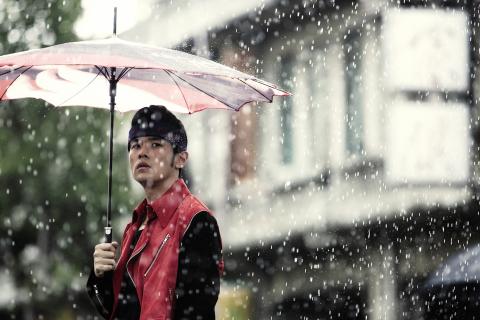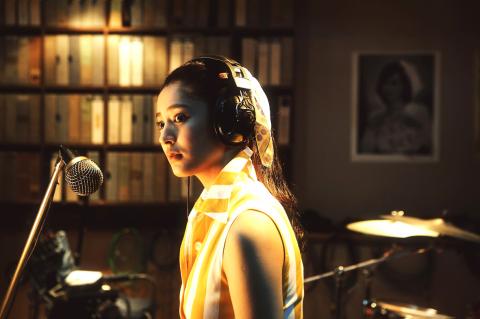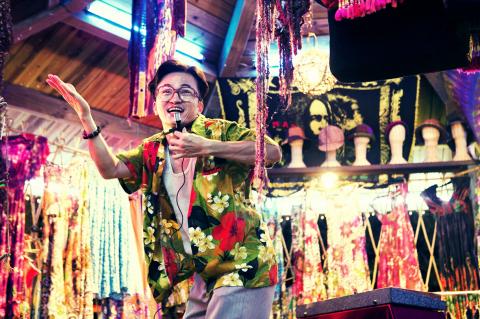Six years after his directorial debut Secret (不能說的祕密), Mando-pop star Jay Chou (周杰倫) returns with The Rooftop (天台), a hyper-ostentatious musical in which he realizes the dream of every straight boy by becoming a kung-fu hero and winning the lady’s heart.
But unlike the well-crafted Secret, a simple but satisfying puppy-love story, Chou’s ambitious second feature has gone too far in its pursuit of technical excellence and loses sight of its purpose of telling a relatable story.
Set in the fictional city of Galilee, the movie centers on Wax (Chou) and his buddies, a carefree bunch who while their youthful days away riding around town, getting into trouble and helping out at Dr. Bo’s (Hong Kong veteran Eric Tsang, 曾志偉) Chinese medicine pharmacy, where they learn kung-fu from the jolly old Bo.

Photo courtesy of Chuang Ying Picture
By night, the friends return home to the titular Rooftop, a ramshackle settlement built on top of an old building in the seedy part of town. Though penniless, the rooftop’s dwellers are a cheerful gang, ready to burst into song and dance at any time and take care of each other like a big family.
Wax’s blithe life changes when he meets his dream girl Starling — played by newcomer Li Xinai (李心艾) from China — who has been forced into the entertainment business by her gambling father (Hong Kong’s Chung Chun-to, 鍾鎮濤).
Wax soon wins the belle’s heart, but their innocent love doesn’t last long. Facing the rich and corrupt movie star William (Taiwanese singer Darren, 邱凱偉), who salivates over Starling’s beauty, and a band of much more sinister mobsters, the hero must prove his mettle and save the girl from falling into the hands of the wicked.

Photo courtesy of Chuang Ying Picture
Credited as director, scriptwriter, actor and songwriter, Chou successfully creates a visually opulent fairy tale bursting with retro sensibilities, with a little help from his top-notch international production crew including cinematographer Mark Lee (李屏賓).
Vintage cars, disco colors and hippie-inspired fashion fill every frame, while the meticulous work of multi-award winning costume designer Wu Li-lu (吳里璐) renders the movie a male version of Sex and the City.
The same amount of effort is invested in crafting the movie’s atmosphere. From the bright neon lights at Bo’s pharmacy, to the romantic backdrop on the rooftop that recalls Baz Luhrmann’s Moulin Rouge!, the ornate sets by the internationally acclaimed art director Akatsuka Yoshihito from Japan — whose works include Kill Bill I and Seediq Bale (賽德克巴萊) — firmly root the movie in a fantastic realm with all traces of reality removed.

Photo courtesy of Chuang Ying Picture
A spectacular example is the night market scene at which the love between Wax and Starling buds. Built from scratch in a scenic area in Greater Tainan, the bustling night market looks like a glittery mirage floating on a lake, accessible only by swan-shaped paddleboats.
To Chou’s credit, the movie is not short on audiovisual wonders, which are part of any musical’s allure. The musical numbers are masterfully choreographed and occasionally show off Chou’s well-trained biceps. Sometimes, stunning visual effects are not created with a computer, but by ingenious camera work and clever art design.
The technical perfection, however, cannot make up for the absence of genuine emotions and feelings necessary for keeping viewers engaged and moving along with the melodramatic flow. The Rooftop is essentially all about Jay Chou, the Mando-pop king. His part doesn’t demand much acting: Chou plays himself and spends considerable screen time wooing the girl, who doesn’t do much except smile sweetly, and hanging out with his real-life buddies such as Devon Song (彈頭). The rest of the movie is Chou’s fantasy come true: He is the martial-arts hero who beats up bad guys and saves the beauty. Unfortunately, neither the star nor his fantasy is particularly interesting.
With hackneyed plots and wooden performances by the two leads, Chou’s The Rooftop remains a glossy confection, impressive at first sight but quickly forgotten.

Exceptions to the rule are sometimes revealing. For a brief few years, there was an emerging ideological split between the Democratic Progressive Party (DPP) and Chinese Nationalist Party (KMT) that appeared to be pushing the DPP in a direction that would be considered more liberal, and the KMT more conservative. In the previous column, “The KMT-DPP’s bureaucrat-led developmental state” (Dec. 11, page 12), we examined how Taiwan’s democratic system developed, and how both the two main parties largely accepted a similar consensus on how Taiwan should be run domestically and did not split along the left-right lines more familiar in

As I finally slid into the warm embrace of the hot, clifftop pool, it was a serene moment of reflection. The sound of the river reflected off the cave walls, the white of our camping lights reflected off the dark, shimmering surface of the water, and I reflected on how fortunate I was to be here. After all, the beautiful walk through narrow canyons that had brought us here had been inaccessible for five years — and will be again soon. The day had started at the Huisun Forest Area (惠蓀林場), at the end of Nantou County Route 80, north and east

Specialty sandwiches loaded with the contents of an entire charcuterie board, overflowing with sauces, creams and all manner of creative add-ons, is perhaps one of the biggest global food trends of this year. From London to New York, lines form down the block for mortadella, burrata, pistachio and more stuffed between slices of fresh sourdough, rye or focaccia. To try the trend in Taipei, Munchies Mafia is for sure the spot — could this be the best sandwich in town? Carlos from Spain and Sergio from Mexico opened this spot just seven months ago. The two met working in the

This month the government ordered a one-year block of Xiaohongshu (小紅書) or Rednote, a Chinese social media platform with more than 3 million users in Taiwan. The government pointed to widespread fraud activity on the platform, along with cybersecurity failures. Officials said that they had reached out to the company and asked it to change. However, they received no response. The pro-China parties, the Chinese Nationalist Party (KMT) and Taiwan People’s Party (TPP), immediately swung into action, denouncing the ban as an attack on free speech. This “free speech” claim was then echoed by the People’s Republic of China (PRC),